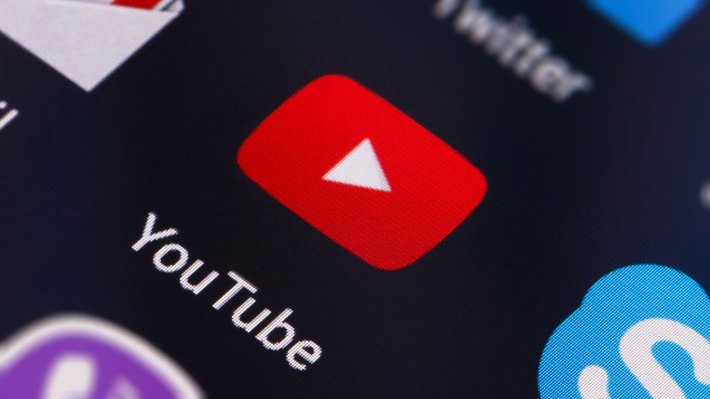YouTube creators are gaining a number of new tools to generate revenue from their videos outside of traditional advertising, as well as those that will help them better engage their fans, according to news the video streaming site announced today at the VidCon conference in Anaheim, California. This includes the rollout of channel memberships, merchandising, marketing partnerships via FameBit and the launch of “Premieres,” which offers a middle ground between pre-recorded, edited video and live streaming.
Memberships
Before today, YouTube had offered a Twitch-like “Sponsorship” model on YouTube Gaming. This gave fans the ability to sponsor a channel for $4.99 per month, which also gave them access to exclusive digital goods, like a custom badge and emoji.
YouTube started testing this program across its larger video network last fall, it said. Those tests led to YouTube channel memberships.
Unlike on YouTube gaming, Channel memberships have additional requirements.
Creators will need to have 100,000 subscribers or more, be over 18 and be members of the YouTube Partner Program.
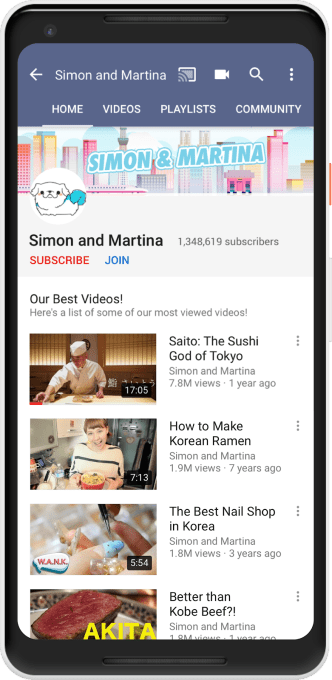
However, the price point for backing a creator’s channel remains the same: $4.99 per month, and includes the custom badges and exclusive emoji.
It will also allow subscribers to gain access to members-only posts in the Community tab where creators will share custom perks from time to time, like access to an exclusive live stream, additional videos, shout-outs, news of upcoming events, early access to ticket sales and other things.
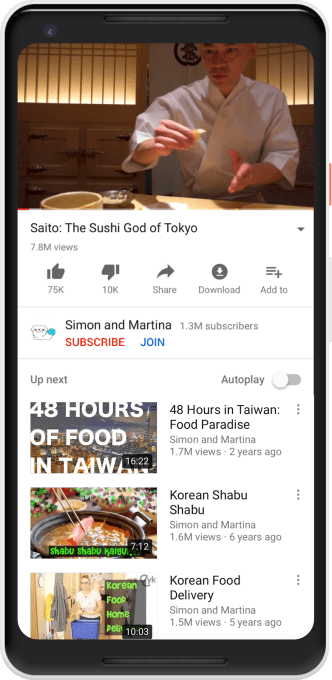
YouTube says it will vet these perks manually, to ensure they meet YouTube’s guidelines and are something the creator can actually deliver.
“This tool set is fairly powerful, so we want to make sure that they don’t put products out there, that they really can’t commit to,” explains Director of Product Management, Rohit Dhawan, who heads alternative monetization at YouTube.
He says the perks can be almost anything the creator wants to offer, within YouTube’s guidelines.
“It’s kind of like a blank canvas…it’s us giving the creators the tools to customize their membership offering and provide whatever perks that they feel is going to be valuable to the fans,” he says.
This feature launched in January for select creators, who have already been generating revenue. It will soon arrive for all who are eligible.
Comedy creator Mike Falzone more than tripled his YouTube revenue, thanks to memberships, says YouTube. Spanish gaming channel elrubiusOMG now has six times the number of members as it did sponsors on YouTube Gaming alone. And Wintergatan is making over 50 percent of revenue from Channel Memberships.
Overall, the number of creators earning five figures a year is up 35 percent, and the number of those earning six figures is up by 40 percent, YouTube says.
Similar to sponsorships, YouTube retains 30 percent of sponsorship revenue after local sales tax is deducted, but covers all transaction costs, including credit card fees.
Merchandise
In addition to memberships, creators will also be able to sell to fans directly, starting today.
In a shelf directly below the video itself, creators with more than 10,000 subscribers can offer merchandise like tee-shirts, hats, phone cases or any one of over 20 different merchandise items that make sense for their channel.
For example, the creator of Lucas the Spider turned his character into a plushie, and sold more than 60,000 units, making over $1 million in profit in just 18 days.
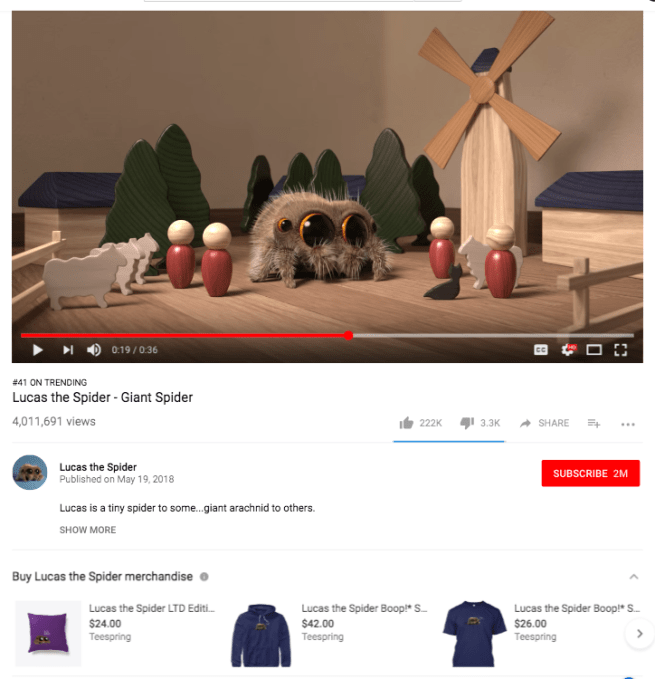
This new program is being launched in partnership with custom merchandise platform Teespring.
YouTube says that Teespring will retain a cut of the merchandise, which varies per item. Effectively, the way this works is that there’s a flat price per item sold that goes back to Teespring, but the creator can mark up the item to whatever price they want, then keep the upside.
For example, a single t-shirt’s base price is $10.22, but creators typically sell them for $22. However, if the creators sells 200-499 t-shirts, the base price drops to $9.82, so the creator makes more money.
But YouTube has also negotiated a deal with Teespring where it receives a commission on those sales — a small flat percentage, we’re told — the majority of which is returned to the creator. This is meant to incentivize the creator to sell merchandise through YouTube, as they’ll receive more thanks to this returned commission than if they sold direct.
This is also a massive win for Teespring, which only a few years ago was restructuring its business and laying off staff.
During beta testing, Teespring says there was an 82 percent success rate for YouTubers using the merchandise service, and conversions from views to sales were testing at 2.5 times higher than with standard description links. This led to an average of 25 percent more units sold per user, among early adopters.
In addition, creators who have been connected directly with brand sponsorships via FameBit, the company it acquired in fall 2016, will also be able to use the merchandise shelf to point fans to whatever they’re selling — like video games, apparel or any other product sold online. This feature was announced at VidCon, but hasn’t rolled out at this time.
Premieres
Finally, YouTubers who want to leverage the revenue generation possibilities that come with Live video will have a way to do so without having to actually go live.
Instead, they can use a new YouTube feature called “Premieres” that creates a landing page they can promote ahead of a video’s release. This page will also have a chat feature, like Live videos do, which means creators can use Super Chat and take advantage of Channel Membership perks even if they aren’t doing live content.
The videos are uploaded in the same interface on YouTube, so there’s no new workflow to learn beyond toggling the “Premiere” switch on.
Creators can also join in the chats as the video goes live to engage with their fans around this pre-recorded content, as well as comment on the videos before they start. When the Premiere wraps, it’s posted as a regular video on the site (without the two-minute countdown video YouTube adds).
“We’re going to use our search and discovery platform to promote these,” notes Kurt Wilms, Group Product Manager at YouTube, who’s leading Live.
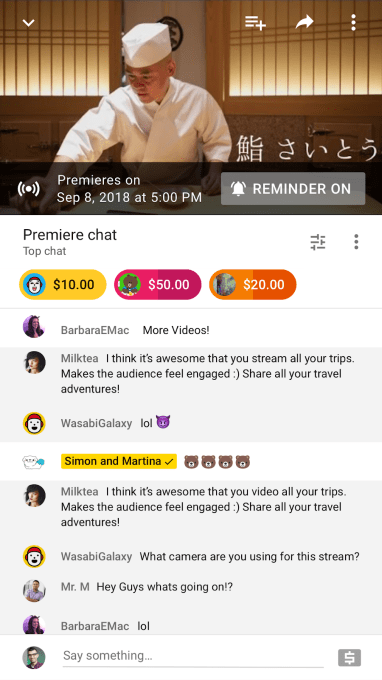
“Upcoming premieres can appear on the [YouTube] homepage and in recommended videos,” he says. Premieres will also show in the section where all the channel content you’ve subscribed to displays, we’re told. And Premieres will be in YouTube search and YouTube related videos.
“They’re going to appear across all the dedicated discovery portions of our site, which is awesome,” he says.
Premieres can be used to promote upcoming videos from creators as well as things like new movie trailers from studios, trailers from video games, or even music videos. But Premieres is not tied to YouTube Music at this time.
A number of YouTube creators will be turning on Premieres after VidCon, including Simon & Martina, Leroy Sanchez, Jackson Bird, Los Polinesios, Ari Fitz, ZerkaaPlays, Theskorpionshow, Laura Kampf, Vintage Space, Yammy, R.LUM.R., JacksFilms, Corridor Digital and Innana Sarkis.
YouTube also said its version of Stories will arrive for all eligible creators with more than 10,000 subscribers later this year.
The announcements come at a critical time for YouTube, as Facebook is trying to woo creators away to its own network and video hub with unique features of its own.
The news also follows another announcement YouTube made to advertisers this week, about new ways they’ll be able to connect with their audience using a Creative Suite of ad tools.
